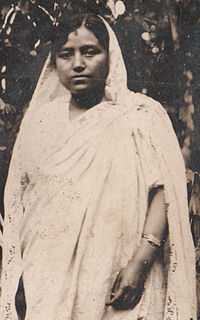Vidyabati Kansakar

Vidyabati Kansakar (Devanagari: विद्याबति कंसकार) (1906 – 31 January 1976) was a pioneer of nursing in Nepal. She was among the first batch of four girls sent abroad to receive nurse training in 1928. They served at Nepal's only hospital Bir Hospital after their education, and became key figures in the development of modern health services in the country.[1]
Early life
Vidyabati was born in Kathmandu to father Yogbir Singh Kansakar and mother Shova Laxmi. The eldest of five children, she lost her mother early in life, and the responsibility of looking after her siblings fell on her. This experience filled her with strength. She received informal education at home from her poet father as the government did not permit girls to go to school.[2]
Career
In 1928, Vidyabati got an opportunity to pursue her interest in serving society when the government decided to send a few girls to India to be trained in modern nursing as there were no nurses in Nepal. She was among the four candidates selected, and when they returned after their education, they became the first nurses in the country.
Nepal's first allopathic hospital Bir Hospital opened in Kathmandu in 1890. It was manned by foreign doctors, but there were no nurses. In a bid to fulfill this lack, the government sent four girls to Allahabad where they underwent an 18-month course in midwifery. They served at Bir Hospital after their return from India.[3][4]
Vidyabati set an example of selfless service with her dedication to her profession. After work at the hospital, she would attend to the patients who thronged her home. She made house calls regardless of the hour. Her income also helped to support the family, as her father was often jailed by the government for writing in Nepal Bhasa, a language it sought to suppress. Her father's cloth shop was a gathering place for poets where they discussed literature. In 1929, he and his companions were arrested and fined by the government for applying to open a public library.[5]
When her ancestral home at Kel Tol was damaged by the Great Earthquake of 1934, she helped her father buy a piece of land and build a new house. Vidyabati and her colleagues worked extra hard treating the wounded after the devastating quake. The experience gave them improved medical skills, and they became even more sought after.
When Vidyabati was in her late 40s, she got diabetes. She was advised to retire, but she continued to maintain a hectic schedule. Her health continued to worsen, and in 1965, she was forced to retire. She was poor of sight and bedridden during her last days.[6]
Honors
Vidyabati Kansakar was awarded the Order of Gorkha Dakshina Bahu by the king of Nepal for her services to the country.
References
- ↑ Nepal Migration Year Book 2010. Kathmandu: Nepal Institute of Development Studies (NIDS). 2011. pp. 59–60. ISBN 978-9937-8112-6-2. Retrieved 6 January 2014.
- ↑ Tuladhar, Lochan Tara (August 2009). "Vidyavati Kasa: The Dawn of Nursing History in Nepal". Matina (London: Amrita Shrestha). pp. 16–17.
- ↑ Nepal Migration Year Book 2010. Kathmandu: Nepal Institute of Development Studies (NIDS). 2011. pp. 59–60. ISBN 978-9937-8112-6-2. Retrieved 6 January 2014.
- ↑ "HRH, Academics & Research". p. 96. Retrieved 8 January 2014.
- ↑ Tumbahang, Govinda Bahadur (January 2010). "Marginalization of Indigenous Languages of Nepal". Contributions to Nepalese Studies. Retrieved 29 January 2014.
- ↑ Tuladhar, Lochan Tara (August 2009). "Vidyavati Kasa: The Dawn of Nursing History in Nepal". Matina (London: Amrita Shrestha). pp. 16–17.